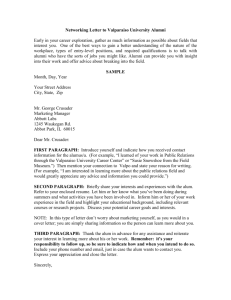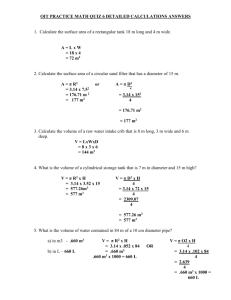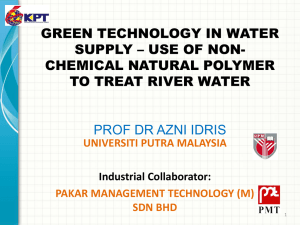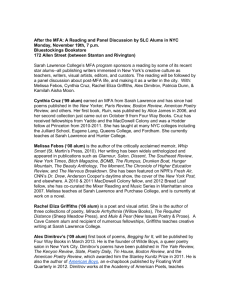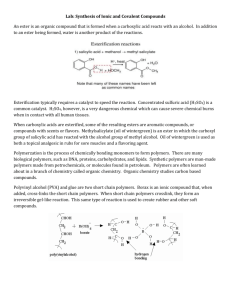Synthesis and Analysis of Alum
advertisement
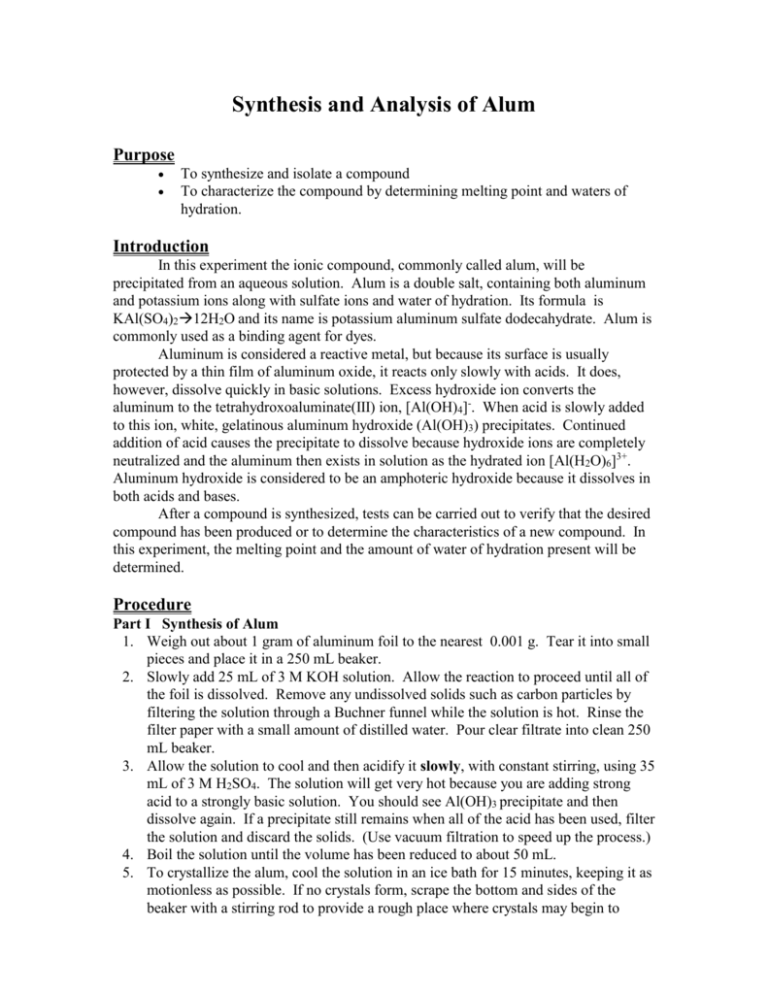
Synthesis and Analysis of Alum Purpose To synthesize and isolate a compound To characterize the compound by determining melting point and waters of hydration. Introduction In this experiment the ionic compound, commonly called alum, will be precipitated from an aqueous solution. Alum is a double salt, containing both aluminum and potassium ions along with sulfate ions and water of hydration. Its formula is KAl(SO4)212H2O and its name is potassium aluminum sulfate dodecahydrate. Alum is commonly used as a binding agent for dyes. Aluminum is considered a reactive metal, but because its surface is usually protected by a thin film of aluminum oxide, it reacts only slowly with acids. It does, however, dissolve quickly in basic solutions. Excess hydroxide ion converts the aluminum to the tetrahydroxoaluminate(III) ion, [Al(OH)4]-. When acid is slowly added to this ion, white, gelatinous aluminum hydroxide (Al(OH)3) precipitates. Continued addition of acid causes the precipitate to dissolve because hydroxide ions are completely neutralized and the aluminum then exists in solution as the hydrated ion [Al(H2O)6]3+. Aluminum hydroxide is considered to be an amphoteric hydroxide because it dissolves in both acids and bases. After a compound is synthesized, tests can be carried out to verify that the desired compound has been produced or to determine the characteristics of a new compound. In this experiment, the melting point and the amount of water of hydration present will be determined. Procedure Part I Synthesis of Alum 1. Weigh out about 1 gram of aluminum foil to the nearest 0.001 g. Tear it into small pieces and place it in a 250 mL beaker. 2. Slowly add 25 mL of 3 M KOH solution. Allow the reaction to proceed until all of the foil is dissolved. Remove any undissolved solids such as carbon particles by filtering the solution through a Buchner funnel while the solution is hot. Rinse the filter paper with a small amount of distilled water. Pour clear filtrate into clean 250 mL beaker. 3. Allow the solution to cool and then acidify it slowly, with constant stirring, using 35 mL of 3 M H2SO4. The solution will get very hot because you are adding strong acid to a strongly basic solution. You should see Al(OH)3 precipitate and then dissolve again. If a precipitate still remains when all of the acid has been used, filter the solution and discard the solids. (Use vacuum filtration to speed up the process.) 4. Boil the solution until the volume has been reduced to about 50 mL. 5. To crystallize the alum, cool the solution in an ice bath for 15 minutes, keeping it as motionless as possible. If no crystals form, scrape the bottom and sides of the beaker with a stirring rod to provide a rough place where crystals may begin to Synthesis and Analysis of Alum grow. If there are no crystals, reheat the solution until more water has evaporated and then cool again. 6. Collect the alum crystals by vacuum filtration. Determine the mass of the filter paper before placing it in the funnel. Wash the crystals with 50 mL of a 50% by volume water and ethanol mixture, in which alum crystals are not very soluble. Pull air through the crystals to help dry them. Transfer crystals and filter paper to a premassed watch glass. Allow the crystals to dry overnight at room temperature. 7. Determine the mass of the alum, filter paper and watch glass. Part II Determination of the Melting Point of Alum 1. Pulverize a small amount (pea size) of dry alum. Use a mortar and pestle, or use a watch glass and the bottom of a test tube. Pack the alum in a capillary tube to a depth of about 1 cm. To get the alum into the capillary tube, push the open end of the capillary down into a small pile of alum powder. Turn the tube so the open end is up and bounce the bottom of the tube on the desk top. 2. Using a 1 mm length of rubber tubing as a rubber band, fasten the capillary tube to a thermometer. The alum should be level with the bulb of the thermometer. Insert the thermometer through a split cork and place in a Thiele melting point tube. Heat the tube as indicated in the diagram. Record the temperature at which the alum melts (the white powder becomes clear). Repeat the melting point determination with a new sample and a new capillary tube. Part III Determination of the Amount of Water of Hydration in Alum Crystals 1. Heat a crucible with a cover over a burner flame until it is red hot. Allow it to cool and find the mass. Handle with tongs to avoid getting fingerprints on them. 2. Add about 2 g of alum crystals to the crucible and accurately determine the mass. 3. Set the crucible at an angle in a pipestem triangle, cover loosely with the crucible cover and heat very gently. The alum crystals will melt and the water of hydration will vaporize. After the vapor is apparently driven off, heat more strongly for five minutes. Cool and find the mass of the crucible, cover and anhydrous alum. Calculations Part I 1. Assuming Al is the limiting reagent, calculate the theoretical yield of alum. 2. Calculate the percent yield. Part II 1. Look up the accepted value for the melting point of alum and calculate the percent error in your determination. Part III 1. Calculate the moles of anhydrous alum remaining. 2. Calculate the moles of water that were driven off. 3. Calculate the mole ratio of water to anhydrous alum and write the formula for alum, indicating the number of waters of hydration present. Synthesis and Analysis of Alum Data Part I Mass Al foil Mass filter paper Mass watch glass Mass filter paper, watch glass & alum Mass alum Part II Trial 1 Melting point of alum Part III Mass crucible & cover Mass crucible, cover & alum Mass crucible, cover & anhydrous alum Mass anhydrous alum Mass water lost Results Part I 1 Theoretical yield of alum 2 Percent yield Part II 1 Percent error Part III 1 Moles of anhydrous alum 2 Moles of water 3 Formula for alum Trial 2 Synthesis and Analysis of Alum Questions 1. List three reasons why you should not expect 100% yield? Be specific and explain. 2. Comment on the results of the different tests used to verify that the substance tested was alum. How confident are you that you made alum? 3. Give three other tests that could be used to verify the composition and/or identity of alum.

